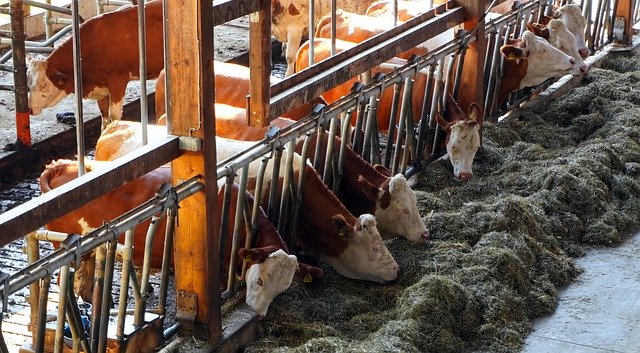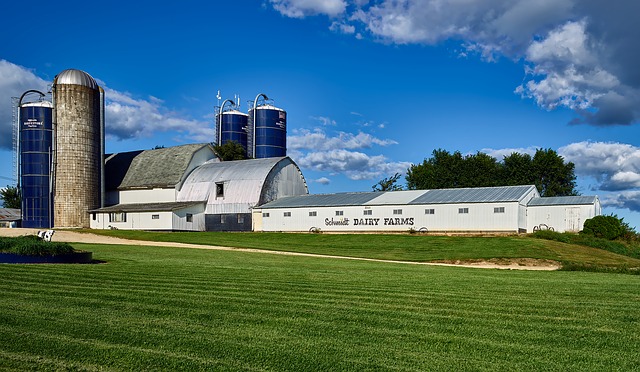We all know there is high demand for dairy products in the market. Dairy products like chocolate, candy, cakes, milk bar, butter, paneer, sweets, and so on have a huge demand in the world market. Overall all humans, directly and indirectly, consume dairy products. Do you ever know that milk was the main food source in ancient times when people did cattle farming to get milk? 12000 years ago men domesticated cattle for the purpose of dairy production. However, over one billion people’s livelihoods depend on dairy farming and supporting other dairy sectors in the world.
What is Dairy Farming?
Dairy farming is a long-term milk production agricultural practice and its main purpose for it is to sell milk. It is mainly commercial farming where farmers rear their cattle for producing milk and selling them in the market. Cows are the main animals for milk production. In commercial dairy farming farmers rear sheep, buffaloes, goats, donkeys, camels, etc. for an alternative source of milk production. We all know that Animal husbandry is the major sector of earning money for the rural area in India. Villagers depend on dairy agriculture for their livelihood.
Indian government launched various dairy farming projects to provide benefits for farmers. Them, distributing dairy animals to the villagers is one of them. The government takes schemes that provide well training to the rural village people. In training centers, villagers can able to learn how to do cow farming, goat farming, sheep farming which is the main source of dairy production.

Features:
- In this farming process high breed milch animals mainly cows and buffaloes are reared by well-trained farmers.
- Dairy farming is high capital-intensive farming.
- In this farming method, a large scale of land is needed.
- In the beginning, farmers need high capital to do that farming. The process of animal sheds, mulching machines, feeding and storage facilities, etc. required a high amount.
- Farmers need to give special health care, veterinary service, and cattle breeding.
- Trained laborers involved in feeding, taking care of cattle, and milking process.
- Proper facilities are required for the transportation and refrigeration of milk.
- The demands for dairy products are high in industrial and urban areas.
- The modern method increased the duration of dairy storage products.
Benefits:
1. Health benefits:
Milk is the natural source of nine essential nutrients so it is called a nutrient powerhouse. We humans need to consume milk daily to get those good healthy nutrients. Various types of research show that people who are fond of drinking milk and consuming milk products have good health. Dairy foods are associated with bone health improvement. Milk is essential to kids and teens; adults can consume who have lower blood pressure and cardiovascular disease.
2. Product versatility:
The most important benefits of dairy are product versatility. Do you ever think about how many products are derived from milk? Here few names of products that are prepared from milk- cheese, paneer, candy, yogurt, sweets, ice cream, butter, ghee, etc. In soup and chocolate, it is also used; preparing biscuit milk is an essential ingredient, and in snacks we use it to add some flavor.
3. Local Supply:
Milk is one of the fresh local products that supply locally. If you want to buy fresh milk then you can get it from your local milk seller.
4. Huge Economic Impact:
Dairy agriculture is very important for our economy mainly for the local economy. It opens a new path for unemployed young people. There are immense dairy industries where they can get jobs with some training. In annual economic revenue, dairy industries contribute impactfully.
5. Passion and Care:
Farmers’ families passionately care for their cattle animals. Though they do this farming for financial purposes they have cared for the domestic animals.
6. Clean Label:
In the present situation, the big challenge of the dairy industry is the systematic decline of fluid milk sales. Like other beverages milk doesn’t contain chemical processes to make, it is natural. So we can tell the clean label of it is fresh chemical-free.
7. Stronger Infrastructure:
Dairy industries create many job vacancies across the country. According to studies major percentages of those major jobs come from farm level and from dairy processing activities.
8. Faith-Based Heritage:
Dairy production is totally faith-based heritage. Farm families have faith that a newborn calf one day will be productive, so they have meals together, and pray together. It is our farming culture that still exists in our society.

Dairy Farming Project In India:
Behind the increase of dairy products, there are lots of positive impacts of Government schemes. The government always tries to help the farmers financially to the improvement of this farming method. Beneficiaries’ schemes that were launched by the government helped to develop dairy production and dairy business in rural places. Farmers or cattleman can develop their farming by taking banking loans, and government dairy farming project.
Before starting a dairy cow farming project farmers need to farm training from locals. Besides a good business plan is also important to buy animals’ breeds and sell their milk. Good milking skill is very essential to make successful dairy production.
Dairy Farming Loan In India:
Indian government launched NABARD dairy farming loan for dairy farmers. This project provides beneficiaries to the farmers. National Bank for Agriculture and Rural Development manages credit-related concerns. It is the best govt loan for dairy farming in India. People who will be eligible for this subsidy scheme are:
- Must be Indian farmers.
- Group of organised sectors.
- Companies, sectors, farms.
- NGO’s
- Individual business person.
Dairy Farming Business Plan:
The dairy farm is a major, lucrative business because dairy farm is an all-season business. The demand for milk is either constant or increasing regardless of the season. Demand for milk and dairy products has not declined in India. The dairy farming business plan needs these steps to follow:
1. Land Selection:
The first and most important thing for setting up a dairy farm is to select a suitable place for the farm. The considerations for selecting a suitable place for the farm are –
- The place should be dry, elevated, and flat so that rainwater does not accumulate and farm waste can be easily disposed of.
- Adequate transportation is required for the marketing of dairy and dairy products and purchase of farm produce.
- Dairy farms must be away from settlements and crowded roads. There should be no wetlands around the farm.
- It should be no wetlands around the farm and must be an opportunity to grow the farm in the future
- There must be an abundant supply of pure, clean and gentle water at low cost and facilities for supply of electricity and gas.
- It is easy and cheap to get regular workers. There should be enough space for grass cultivation.
2. Housing:
Adequate housing is essential to protect farm cows from various types of natural disasters, wildlife, thieves, etc., and to provide better comfort and better management. The considerations when constructing a cow dwelling or house are that the cow house will be longer from east to west. Houses must face south. There should be adequate lighting and ventilation. The floor of the house will be paved and rough. This makes the cow less likely to slip and fall. The floor of the house should be sloping and a drainage system should be maintained so that dung, gram, etc. can be easily cleaned.
3. Selection of dairy cow:
Good quality seeds are required to get a good yield from the land. Similarly, in order to make a dairy farm profitable, cows should be selected which will give more milk. Some of the things to look for when selecting a cow are:
- Breed
- Pedigree
- Production records
- Physical appearance
- Health
4. Feeding:
A balanced diet is required to protect the body of dairy cows, milk production, and proper growth of fry during pregnancy. The cost of food on livestock farms is about 60% of the recurring cost. Reducing food costs as well as increasing production is a kind of adventurous responsibility. In order to fulfill this responsibility, it is necessary to acquire complete knowledge about the nutritional value of the food items obtained at low cost, the composition of the food, and the method of feeding the food. Depending on the daily milk production of the cow, it is important to have 50 to 60% fiber in the feed.
Since the level of dry straw is less, it is better to process the straw and feed it to the cows. Many of our native green grasses do not have this level of nutrition. However, the obtained green grass should be fed to the cows and the surplus grass should be stored so that it is possible to reduce the cost of food by using it in times of scarcity.
5. Marketing:
The main product of the farm is milk. Milk is a perishable product. So the first thing to consider when setting up a farm is whether milk can be sold regularly at the desired price or not. In addition, other by-products produced on the farm must be sold at the right price in a timely manner. So, it is not possible to make a farm profitable without proper marketing.

Dairy farm:
The role of dairy farms in increasing milk production, creating self-employment, and alleviating poverty in our country is undeniable. Every step from the beginning to the end of setting up a dairy farm is woven in the same thread. Just as you have to think about different things before setting up a farm, you have to pay close attention to different management of the farm after setting up a farm. Milk is the main product of dairy farming. Therefore, it is necessary to have knowledge about the milk marketing system.
Conclusion:
The purpose of setting up a farm is to make a profit from it. So it is important to know about the income and expenditure of dairy farms. Many set up farms with loans from banks. Knowledge of how to repay this loan is also required.